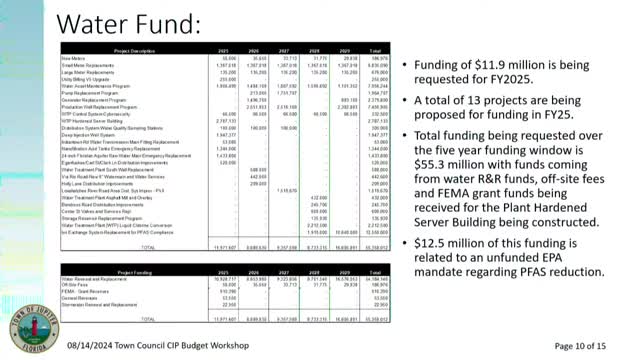Utility faces costly challenge to meet new PFAS regulations
August 14, 2024 | Jupiter, Palm Beach County, Florida
This article was created by AI summarizing key points discussed. AI makes mistakes, so for full details and context, please refer to the video of the full meeting. Please report any errors so we can fix them. Report an error »

In a recent government meeting, officials discussed the impending Environmental Protection Agency (EPA) mandate regarding the reduction of per- and polyfluoroalkyl substances (PFAS) in drinking water, set to take effect in 2029. Amanda Barnes, the director of the utility, provided an overview of the challenges posed by this unfunded mandate, emphasizing the financial burden it places on local utilities, particularly smaller ones that may struggle to comply.
PFAS, a group of manmade chemicals including PFOA and PFOS, have been linked to various health risks and are commonly found in products such as water-repellent fabrics and firefighting foams. Although the EPA banned the use of these chemicals in 2000, they persist in the environment and can accumulate in the human body, leading to concerns about water safety.
Barnes noted that while the local water supply in Jupiter has not been contaminated with PFAS, the utility must prepare for the new regulations that set a detection limit of four parts per trillion. Current infrastructure, including an ion exchange facility, is inadequate to meet this standard. The utility plans to construct a calcite contactor to further treat water produced by its reverse osmosis plant, which is expected to help stabilize the water quality.
The discussion highlighted the need for strategic planning and investment to ensure compliance with the new regulations, as well as the potential for increased costs to consumers. The utility is also exploring alternative options for PFAS removal, but the financial implications of expanding existing facilities or changing treatment methods remain a significant concern.
PFAS, a group of manmade chemicals including PFOA and PFOS, have been linked to various health risks and are commonly found in products such as water-repellent fabrics and firefighting foams. Although the EPA banned the use of these chemicals in 2000, they persist in the environment and can accumulate in the human body, leading to concerns about water safety.
Barnes noted that while the local water supply in Jupiter has not been contaminated with PFAS, the utility must prepare for the new regulations that set a detection limit of four parts per trillion. Current infrastructure, including an ion exchange facility, is inadequate to meet this standard. The utility plans to construct a calcite contactor to further treat water produced by its reverse osmosis plant, which is expected to help stabilize the water quality.
The discussion highlighted the need for strategic planning and investment to ensure compliance with the new regulations, as well as the potential for increased costs to consumers. The utility is also exploring alternative options for PFAS removal, but the financial implications of expanding existing facilities or changing treatment methods remain a significant concern.
View full meeting
This article is based on a recent meeting—watch the full video and explore the complete transcript for deeper insights into the discussion.
View full meeting